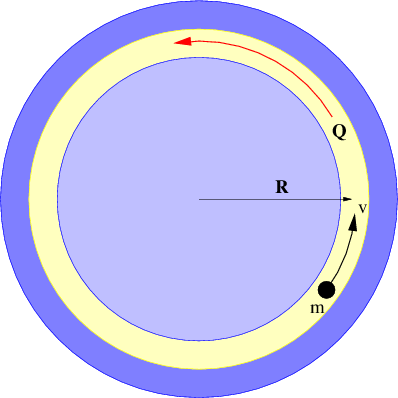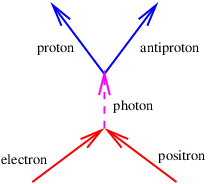14.9: Problems
( \newcommand{\kernel}{\mathrm{null}\,}\)
- An alternate way to modify the energy-momentum relation while maintaining relativistic invariance is with a “potential mass”, H(x): E2=p2c2+(m+H)2c4
If |H|≪m and p2≪m2c2, show how this equation may be approximated as E= something +p2/(2m) and determine the form of “something ” in terms of H. Is this theory distinguishable from the theory involving potential energy at nonrelativistic velocities?
- For a given channel length L and particle speed in Figure 14.9.1:, determine the possible values of potential momentum ±Q in the two channels that result in destructive interference between the two parts of the particle wave.
- Show that equations (14.14) and (14.15) are indeed recovered from equations (14.12) and (14.13) when Q points in the y direction and is a function only of x.
- Show that the force F = v × P is perpendicular to the velocity v. Does this force do any work on the particle? Is this consistent with the fact that the force doesn’t change the particle’s kinetic energy?
- Show that the potential momentum illustrated in Figure 14.9.2: satisfies the Lorenz condition, assuming that U = 0. Would the Lorenz condition be satisfied in this case if Q depended only on x and pointed in the x direction?
- A mass m moves at non-relativistic speed around a circular track of radius R as shown in Figure 14.9.7:. The mass is subject to a potential momentum vector of magnitude Q pointing counterclockwise around the track.
- If the particle moves at speed v, does it have a longer wavelength when it is moving clockwise or counterclockwise? Explain.
- Quantization of angular momentum is obtained by assuming that an integer number of wavelengths n fits into the circumference of the track. For given |n |, determine the speed of the mass (i) if it is moving clockwise (n< 0), and (ii) if it is moving counterclockwise (n> 0).
- Determine the kinetic energy of the mass as a function of n.
Figure 14.9.7:: The particle is constrained to move along the illustrated track under the influence of a potential momentum Q.
- Suppose momentum were conserved for action at a distance in a particular reference frame between particles 1 cm apart as in the left panel of Figure 14.9.4: in the text. If you are moving at velocity 2 × 108 m s-1 relative to this reference frame, for how long a time interval is momentum apparently not conserved? Hint: The 1 cm interval is the invariant distance between the kinks in the world lines.
- An electron moving to the right at speed v collides with a positron (an antielectron) moving to the left at the same speed as shown in Figure 14.9.8:. The two particles annihilate, forming a virtual photon, which then decays into a proton-antiproton pair. The mass of the electron is m and the mass of the proton is M = 1830m.
- What is the mass of the virtual photon? Hint: It is not 2m. Why?
- What is the maximum possible lifetime of the virtual photon by the uncertainty principle?
- What is the minimum v the electron and positron need to have to make this reaction energetically possible? Hint: How much energy must exist in the proton-antiproton pair?
Figure 14.9.8:: Electron-positron annihilation leading to proton-antiproton production.
- A muon (mass m ) interacts with a proton as shown in Figure 14.9.9:, so that the velocity of the muon before the interaction is v, while after the interaction it is −v/2, all in the x direction. The interaction is mediated by a single virtual photon. Assume that v≪c for simplicity.
- What is the momentum of the photon?
- What is the energy of the photon?
Figure 14.9.9:: Collision of a muon with a proton, mediated by the exchange of a virtual photon.
- A photon with energy E and momentum E/c collides with an electron with momentum p=−E/c in the x direction and mass m. The photon is absorbed, creating a virtual electron. Later the electron emits a photon in the x direction with energy E and momentum -E∕c. (This process is called Compton scattering and is illustrated in Figure 14.9.10:.)
- Compute the energy of the electron before it absorbs the photon.
- Compute the mass of the virtual electron, and hence the maximum proper time it can exist before emitting a photon.
- Compute the velocity of the electron before it absorbs the photon.
- Using the above result, compute the energies of the incoming and outgoing photons in a frame of reference in which the electron is initially at rest. Hint: Using Ephoton =ℏω and the above velocity, use the Doppler shift formulas to get the photon frequencies, and hence energies in the new reference frame.
Figure 14.9.10:: Compton scattering.
- The dispersion relation for a negative energy relativistic particle is ω=−(k2c2+μ2)1/2
Compute the group velocity of such a particle. Convert the result into an expression in terms of momentum rather than wavenumber. Compare this to the corresponding expression for a positive energy particle and relate it to Feynman’s explanation of negative energy states.
- The potential energy of a charged particle in a scalar electromagnetic potential ϕ is the charge times the scalar potential. The total energy of such a particle at rest is therefore E=±mc2+qϕ
where q is the charge on the particle and ±mc2 is the rest energy, with the ± corresponding to positive and negative energy states. Assume that |qϕ|≪mc2.
- Given that a particle with energy E<0 is equivalent to the corresponding antiparticle with energy equal to −E>0, what is the potential energy of the antiparticle?
- From this, what can you conclude about the charge on the antiparticle?
Hint: Recall that the total energy is always rest energy plus kinetic energy (zero in this case) plus potential energy.

